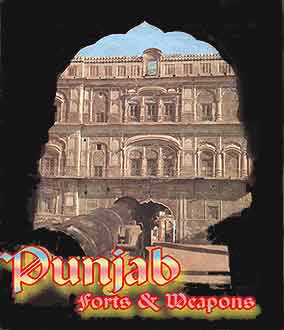
FORTS & WEAPONS OF THE PUNJAB
The Punjab has a past echoing with the thunder of battle and the rise and fall of empires as its myths merge into the history of a stalwart people.
This green and golden 'land of he five rivers' whose story emerges from legends to become history, has always attracted invaders across the border, some of whom came to plunder, some to rule. Gods walked the earth to aid rival brothers during the epic wars of the Mahabharta. The history of India for centuries to come was decided at the battlefield of Panipat as Babar and his guns laid the foundations of the mighty Mughal empire, which in turn, gave way to British rule.
Today, blossoming with wheat and prosperity, it is the land of an exuberant people - a singing, dancing, smiling people. The fierce, turbulent past hovers only around the many silent, ruined forts and the weapons preserved in museums.
The
Story of Weapons
The evidence of weapons in the Punjab stretches
back into prehistoric times. Neolithic and Paleolithic stone tools and axes were
discovered in the Shivalik hills, Kangra, Rathpur near Ambala and Dholbaba in
the district of Hoshiarpur. The weapons kept pace with the times. Excavations
at Harappa produced seals showing men defending themselves with shields. Copper
arrowheads, knives, axes, and spearheads of various shapes show that the civilisation,
which flourished here, used fairly advanced weapons.
The ancient Hindu scriptures,
the Vedas, compiled in 1500 BC, go on to make frequent references to archery.
When Porus defended his kingdom against Alexander the Great, armour was in such
extensive use that even the elephants in his army were encased in protective metal.
Porus himself, according to historians, was completely clothed by a coat of mail
except for an unprotected right shoulder.
The Greeks did not stay on in India,
their only legacy being newer weapons and fighting techniques. The sword became
an important weapon and figures on the Kushan and Gupta coins of the time. In
a famous stone sculpture of the 'headless Kanishka', the emperor is shown holding
a long sword.

1.17th Century Maratha Weapon, Patiala Museum.
2. 18th C. battle axe. Patiala fort.
3. 17th.C. Arabic sword. Patiala Museum
4. 18th century sword with flintlock pistol. Patiala Fort.
5. 18th C. dagger. Patiala Museum..
6.Sword of Nadir Shah, the 18th c. conqueror. Patiala Fort.
7. Katar. Patiala Fort.
8. Toothed, curved sword, Patiala Fort.
9. 19th C. Mughal dagger, Patiala Museum.



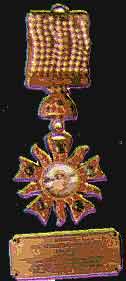
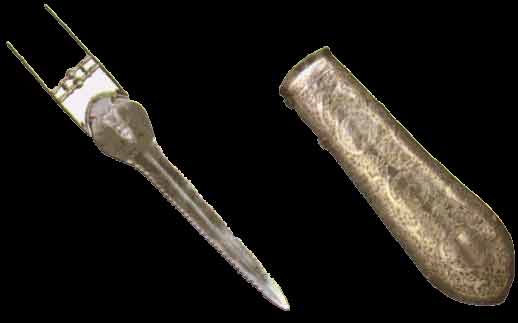

The Sikhs who have almost become synonymous with the martial personality of the Punjab, were born in the face of persecution by the Muslim rulers and developed into India's foremost fighting men. Though they invented no new weapons, they discarded those that did not suit their methods of warfare. They retained the sword, spear, lance, chahia, helmet, body armour and shields. Their firearms consisted of cannons, matchlock guns, flintlock guns, zanzail, zambura, percussion cap, gun, pistol, howitzer and mortar. All these weapons implied a fusion of several styles. The hilts, guards and scabbards of the swords of Sikh nobility were richly decorated with gold and studded with jewels. The blade of Maharaja Ranjit Singh's sword was valued at £ 1000 while the hilt and scabbard were worth five times that amount. Many ancient weapons can now be seen in the Chandigarh and Patiala museums.
This museum has a rare and extensive collection of weapons. Many swords exhibited here are inscribed with verses from the Quran. The famous sword of Nadir Shah, known as 'Shikar Gah', depicts hunting scenes. The sword of Shah Abbas of Persia has the owner's name and the name of a noted swordsmith of the time carved on it. Other interesting helmets, shields and arm protectors depict Persian court scenes. How to get there Patiala is 67 km from Chandigarh by road and 225 km from Delhi by road. Well connected by train and bus services with all important towns of the Punjab and neighbouring states.
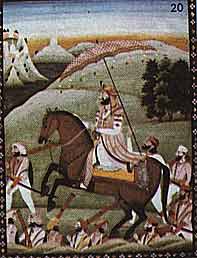
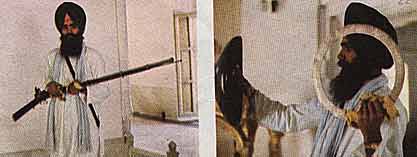

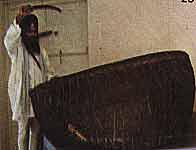
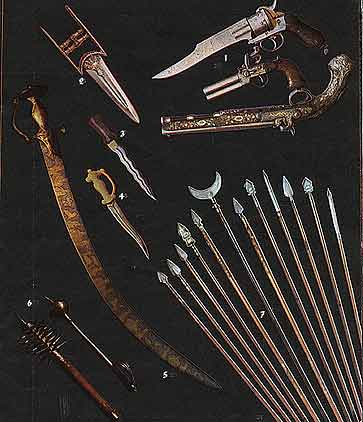
1.A variety of pistols.
2. 17th Century Katar.
3. 19th C. dagger of Sardar Fateh Singh.
4. 17th century dagger of Guru Gobind Singh Ji.
5. 18th century sword. Patiala Fort.
6. Nailed mace or kharmai. Patiala Fort.
7. 16th to 18th century arrows. Patiala Fort.
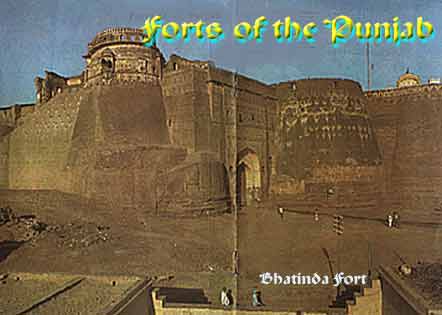
BHATINDA FORT
Said to have been built by Bhatti Rao, Bhatinda is one of the oldest towns of the Punjab. Its schooner shaped fort once boasted ten massive bastions. Successive rulers madea number of additions to the fort so that very little of its original form remains today. Inside is a small gurdwara dedicated to Guru Gobind Singh.
Mohammed Ghori was one of the first foreign invaders of Bhatinda. Later the fort was captured by Maharaja Ala Singh in 1754 AD. Empress Razia Sultana, the first woman ruler of India, was imprisoned here by her enemies before she was executed.
Today bhatinda is a thriving modern township and the leading foodgrains and cotton centre in the state. It also boasts a modern thermal power plant.
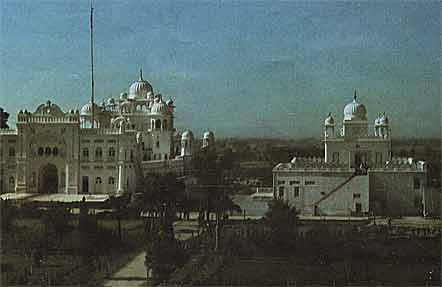
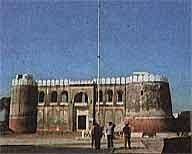
ANANDPUR SAHIB
Picturesquely set against the Naina Devi ranges, this brick fort was built by Guru Gobind Singh Ji, the tenth Sikh Guru. The famous gurdwaras of 'Seesganj' where the Guru cremated his father's head after his martyrdom in Delhi, and Keshgarh Sahib where Guru Gobind Singh baptised the first five Khalsas or pure ones, are both only a short distance away. Over the years, Anandpur Sahib has become an important religious centre for the Sikhs. Meaning the Abode of Peace it houses a complex of gurdwaras each with some religious association. Every year during the Holi celebrations in March-April, thousands of Sikh pilgrims meet here to participate in a fair known as Hola Mahalla. The highlight of the celebrations is a re-enactment of a Sikh cavalary charge.
BAHADURGARH FORT
In 1658 Nawab Saif Khan founded the ancient village of Saifabad just 6 km from Patiala. At this time Guru Teg Bahadur visited Saifabad and prophesied the rising of a great fort at the spot. In 1837 Maharaja Karan Singh of Patiala laid the foundations of a fort which was completed in eight years. He named it Bahadurgarh and built a gurdwara outside in memory of the Guru's visit. This fort has two circular ramparts and is surrounded by a moat.
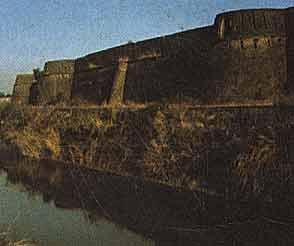
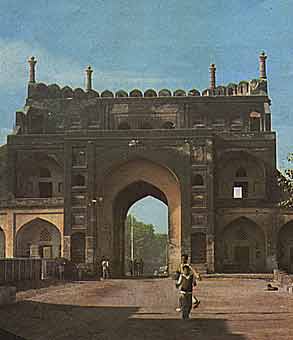
DORAHA SARAI
Situated off the main highway between Ambala and Ludhiana (GT road). These caravan serais were built throughout the land during the Mughal era to provide rest and shade to travellers. Doraha was constructed by Emperor Jahangir for his troops and courtiers. This huge sarai is rectangular in shape and has rooms and verandahs on all sides. Though partly in ruins, two massive, double-storeyed gateways still stand testimony to its ancient grandeur. One of these is profusely decorated with blue and yellow glazed tiles. The other gate is different. Its facade is divided into panels and decorated with carved brick-work. Like other sarais it has a mosque and a well in the court yard.
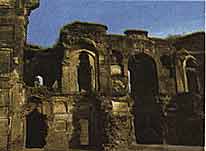
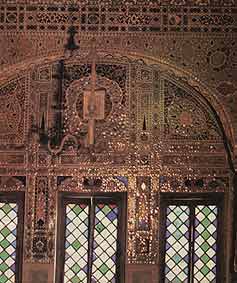
FARIDKOT FORT
Situated near a pre-harrapan mound, the town of Fardikot south-west of Ludhiana is said to have been foundedabout seven hundred years ago by Raja Mokulsi who named it Mokulhai. Some years laterits name was changed to Faridkot after a local sage, Baba Farid. In those days the town was confined within the battlements of its mighty fort. For many years it was constantly subjected to raids by rival chieftains. Maharaja Ranjit Singh also regarded this fort as a place of strategic importance and surrendered it most unwillingly to the British in 1809.
After 1837 the town began to expand and was made the capital of a newly constituted state by the British.
An interesting feature of some forts of the Punjab was the inclusion of a Sheesh Mahal or Hall of Mirrors. On the first floor of the fort is the beautifully designed Sheesh Mahal. The concave and convex glass work here is noteworthy. Some beautiful paintings in the local style decorate the walls and help to enhance the whole effect. There is also some evidence of cloth paintings applied to the walls.
PATIALA FORT
The patiala School of painting bears an ancient tradition. Some fine examples are evident in the old Patiala Fort. The fort dates back to 1763 when Baba Ala Singh laid its foundations with the construction of a 'Kachigarhi' (mud fortress) and named it Qila Mubarak. It comprises two large halls, the old Diwan Khana and the Patiala Museum. Murals were executed in the Pahari, Rajasthani and Patiala styles. The one of Raja Amar Singh wearing emerald robes and jewellery is outstanding. Today the Qila Mubarak is the nucleus of the city and houses an impressive armoury.
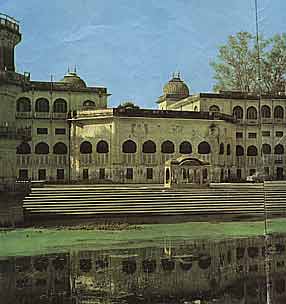
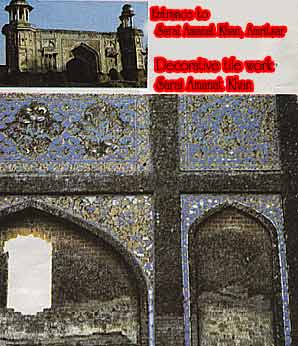
Entrance to Sarai Amanat Khan, Amritsar.
Decorative tile work at the Sarai.
PHILLAUR FORT
Just on the banks of the Satluj River is the unusual Phillaur Fort. Designed by an Italian architect, this fort was originally a Mughal caravanserai. Maharaja Ranjit Singh later converted it into a fort. Today it serves as a Police Training School.
SHAHPUR KANDI FORT
On the left bank of the River Ravi, is the little town of Shahpur. Its 16th century Shahpur Kandi Fort nestles at the foot of the towering Himalayas and overlooks the river. It was built by Bhao Singh who named the fort after the Emperor Shah Jehan. Near the fort are some Muslim Tombs and a mosque. Just outside the village is a typical old stone tank and some wells.

Painting of Maharaja Ranjit Singh, Punjab School, 19th century
Jewels
and Relics from Maharaja
Ranjit Singh's Toshakhana
Article courtesy of Mohinder Singh
AFTER consolidating his victories
and establishing an independent kingdom in Punjab, Maharaja Ranjit Singh built
a unique collection of jewels and relics. The world famous Koh-i-Noor is the most
precious in the category of jewels and the Kalgee of Guru Gobind Singh in the
category of relics. Apart from the relics of the Sikh Gurus, in the Toshkhana
of the Maharaja were also preserved shoes, staff and prayer book of Prophet Mohammad
which his father Maha Singh had acquired from Pir Mohammad Chhatha after the latter's
defeat in the battle of Rasulnagar. According to the popular tradition, the Maharaja
showed same reverence for the relics of Prophet Mohammad which he showed for the
relics of the Sikh Gurus. The Maharaja used to start his day after listening to
the recitation to Gurbani in the morning and taking a Wak from the famous Kartarpuri
Bir.
Ranjit Singh did not wear a crown or sat on a throne in keeping with
the egalitarian tradition of the Khalsa Panth.
The Maharaja's fabulous wealth
and relics were the envy not only of contemporary Indian rulers but also those
of the officials of the East India Company. The following account of the nephew
of Henry Edward Fane, an ADC of Colonel Wade, the British Political Agent posted
in Ludhiana, describes the British astonishment over the fabulous collection of
the Maharaja: "The dresses and jewels of the raja's court were the most superb
that can be conceived; the whole scene can only be compared to a gala night at
the Opera. The minister's son, in particular, the reigning favourite of the day
(Hira Singh) was literally one mass of jewels; his neck, arms and legs were covered
with necklaces, armlets and bangles, forms of pearls, diamonds and rubies, one
above the another, so thick that it was difficult to discover anything beneath
them."
During the marriage of Maharaja's son Kunwar Naunuhal Singh,
the Britishers not only saw the Maharaja wearing the world famous Koh- i -Noor
and his sons and nobles' jewels of fairy tales description, they also discovered
to their dismay the unique training and skill of his troops, both traditional
and those trained on European lines by the French generals employed by the Maharaja.
Gifts assembled for the entourage of Lord Auckland, the newly appointed Governor
General in 1838, also give an idea of the Maharaja's generosity and hospitality
for his state guests.
According to the account given by Misr Beli
Ram, in charge of Maharaja's Toshakhana, Macnaughten, the senior most officer
accompanying the Governor General, was given 15 garments, a pearl necklace, a
jewelled armlet and a jewelled pair of gold bangles, an elephant with a silver
saddle and a jewelled sword.
More than his sons, nobles and distinguished
guests, the Maharaja showed respect for the religious places dear to his Hindu,
Muslim and Sikh subjects. The Maharaja gave tax-free endowments for religious
places and gave costly gifts to Jawalamukhi temple and Baba Farid shrine at Pak
Pattan. The Harmandir Sahib at Amritsar received Maharaja's special attention
and reverence. It was under the orders of the Maharaja that the entire shrine
was re-decorated by beautiful inlay and floral work and walls and canopies of
the Harmandir Sahib were inlaid with gold plating, which then onward came to be
popularly known as Swarn Mandir or the Golden Temple. Whenever the Maharaja visited
Harmandir to seek Guru's blessings, he offered invaluable gifts, which are now
preserved in the Toshakhana of the Golden Temple. A canopy embedded with 20 pounds
of gold and studded with diamonds, emeralds, pearls and rubies, a bejewelled arm
band, a sword with a gold handle studded with jewels and pearls, a peacock made
of sapphire and gilded with diamonds, rubies and other precious stones and other
invaluable jewellry items were presented to the temple by the Maharaja.
After
the death of Maharaja Ranjit Singh in 1839 and the annexation of the kingdom to
the British Empire in 1849, lord Dalhousie, the Governor General of India, took
keen personnel interest in taking possession of the jewels and relics in the Toshakhana
of the Maharaja.
An idea of the intrinsic value of the relics in the Toshakhana
of Maharaja Ranjit Singh can be formed from the following remarks which Lord Dalhousie,
the Governor General of India, made when these objects were being dispatched to
England for presentation to the Queen:
"It would not be politic to permit
any Sikh institution to obtain either by way of gift (for the intrinsic value
of them is significant) or by means of sale of these sacred and warlike symbols
of a warlike faith."
After getting approval from the secretary of state,
the following relics of Guru Gobind Singh were sent to England by ship after getting
them heavily insured: "Shumsheer-wa- Sipar (Sword with Shield). The were
presented on 30th Bysakh, 1880 sumbat (1823 A.D) by one Dya Singh of Peshawar
to Maharaja Ranjit Singh who gave him a well and a suit of clothes (on return).
Dae-I-Ahinee (An iron weapon). A hill man brought this to the Maharaja 28 years
ago. Neza (a lance) was presented to Maharaja Ranjit Singh by the Singhs of Ubchalnagar.
Chukker-I-Ahinee (A circular missile weapon of iron). An Akali Singh presented
this to Maharaja Ranjit Singh at Utuk.
Shumsher Tegha (A scimitar). Taken
from one Baba Bhartee
on 25 Mugger 1878 (or 1821 A.D) and made over to the
Toshakhana, by Maharaja Ranjit Singh.
Kalgee-I-Kuch (A crest of glass in a
silver case). A Sahibzada (descendent of Nanak) of Vyrowal brought this to Maharaja
Ranjit Singh on 7th Chet 1881 (1824 A.D).
Burchee (A small spear). This belonged
to Kumalgarh Raja (Chief of Mundee) who used to worship it. General Ventura got
it, when he took the fort of Kumalgarh and presented it to the Kunwar Nau Nihal
Singh in the month of Magh 1896. Burcha (A large spear) The Khalsa army got this
at Jummoo when they invaded that place. The whole army used to worship it."
Ranjit Singh's golden chair along with boxes full of jewels was also dispatched
for the Board of Directors of the East India Company and the Queen. To ensure
that young Duleep Singh, the last Sikh ruler of the kingdom of Ranjit Singh, should
not become a rallying point for the p eople of Punjab, he was surreptitiously
converted to Christianity and hurriedly sent to England. To minimise all chances
of his return to Punjab and claiming sovereignty after becoming of age, he was
made to marry princess Victoria Gouramma of Coorg, also an Indian convert to Christianity
and settled in Elveden Estate, near Cambridge especially purchased for him. A
facade of a ceremony was arranged in which young price was made to present the
famous Koh-i-Noor to Queen Victoria and 13 most valuable relics pertaining to
Maharaja Ranjit Singh to the Prince of Wales. The remaining jewellry in the Toshakhana
of the Maharaja was either taken over by the British officials in India or auctioned
to public thus putting to an end of the glory and grandeur of the mighty empire
of a mighty ruler of Punjab.
While great enthusiasm created during the tercentenary
of the birth of Guru Gobind Singh in 1966 resulted in the return of the weapons
of Guru Gobind Singh to India and their being placed at Takhat Sri Kesgarh Sahib
in Anandpur, the sacred Kalgee of Guru Gobind Singh still remains untracked.